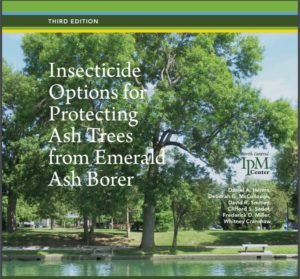Labor issues and timing of tree care activities have been and will continue to be impacted by federal and state rulings as a result of CoVid-19. As a result of social distancing and confusion surrounding “essential services”, many plant health care technicians and business operations have been suspended. As the season progresses, these labor suspensions can make it difficult to apply pesticides and fertilizers when they can most benefit turf, ornamental and overstory trees.
Emerald ash borer, Agrillus planinpennis, continues to be the most serious problem facing ash trees in much of North America. Timing is important to get the best results with the least amount of canopy thinning and health maintenance. Data from several university studies have shown that spring insecticide treatments are consistently more effective than the same treatments applied in fall.
Research conducted in Purdue laboratories on large trees shows that this is particularly important if you are applying at three year intervals. If you are on a three-year schedule, delaying applications until the fall can allow adult beetles to emerge and lay eggs that will develop into larvae. If treatment is delayed until September, many of these larvae will have had the chance to complete most of their development. Although the fall treatment will kill those larvae that actively feeding, as well as any larvae produced the following year, the tree will have to heal from the summer’s injury. Our field trials of large trees treated every 3 years showed more canopy loss (about 40%) in trees receiving fall applications when compared to spring applications (about 20%).
With an inability to treat in the spring, these are your options:
- If you are on a two year treatment schedule of emamectin benzoate::
- Delay applications until the fall. Fall applications will kill larvae this fall and next spring. Fall applications will have you on your clients properties at a time when you can deliver other plant health care services.
- Delay applications until the following spring. Our work and those of others show spring treatments every two years is as effective as every three
- If you are on a three year schedule or if you get a new request to treat for EAB, .
- Get your application in as soon as possible after Covid restrictions are relaxed. During periods of drouth you need to irrigate the tree prior to application to get uptake into the canopy. You may then continue on the same 3 year spring schedule if subsequent years.
Emeraldashborer.info. 2020. Regional Emerald Ash Borer Information Page.
http://www.emeraldashborer.info [accessed 2 March 2020].
Herms, D. A., McCullough, D. G., Smitley, D. R., Sadof, C. S., Miller, F. D., and Cranshaw, W. 2019. Insecticide options for protecting ash trees from emerald ash borer, 3nd edition.
